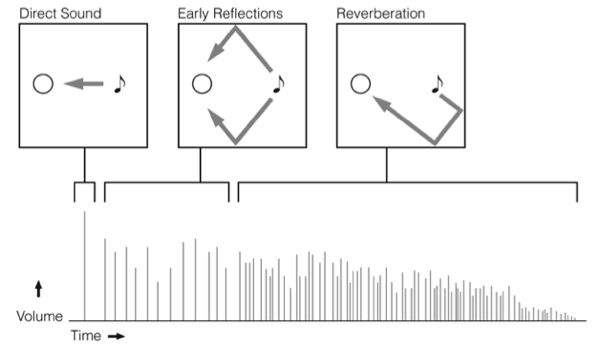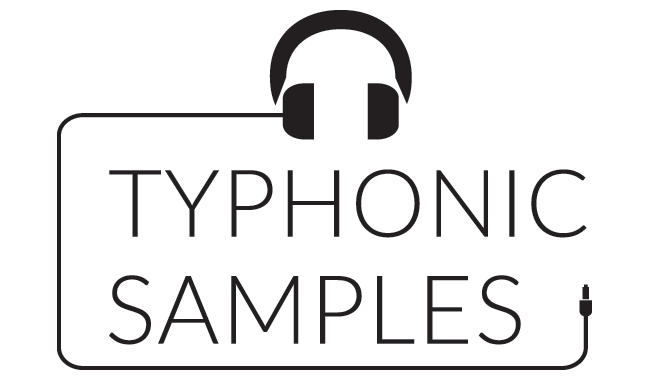As a kid, we’ve all screamed our lungs out when going through a tunnel, maybe some of us still do. We did this simply because we wanted to make a shitload of noise, but also because your voice sounds huge inside the tunnel. This phenomenon is called reverberation (reverb). Reverberation is always present and all around us. But what exactly is reverb and how do you use it in your music productions?
What Is Reverb?
Reverberation, or reverb for short, is the way a sound reflects off surfaces. When there’s a sound, it goes in every possible direction, until it hits a wall or object. Then it bounces off and continues, however the sound waves will lose energy and therefore get quieter. So when you hear a sound, it’s not only directly from the source (which you hear first and loudest), but also from the wall and other objects in your surroundings (which you hear later and quieter).
As this image describes, you have the direct sound, early reflections and the reverberation.

You can compare it with delay. You scream “Echo” into a well; you will hear it again a few moments later when it bounces back. Reverb is the same principal, but the echoes are much closer and your brain can’t hear the different intervals, merging it into one cohesive sound. Think of an old church, you know your voice will sound differently than in your own bedroom.
As you can understand, the reverb of a sound depends on the size and shape of the room you’re in, the objects in it and the materials they are made of. Therefore every sound booth has lots of foam and shapes since sound waves will not reflect that much off it, giving you a clean recording and the possibility to add a (digital) reverb of your choosing.
Why Use Reverb?
Since reverberation is everywhere, a sound without reverb will sound unnatural; it will lack depth and space. So adding reverb to elements of your music productions can be very useful. Please note that using too much reverb – like most effects – could have negative effects on your track. Sounds can get bit distorted, messy or muddy. It really depends on the situation and what you want to achieve.
If you have recorded a clean vocal without any reverb, you should always add some. By adding reverb to vocals they will get more depth and warmth. Even rap or rock vocals will benefit from a small reverb tail. The most important thing is to choose the right type of reverb.
For example, when producing ambient music you should really look into room and hall reverbs. The big room sizes and long reverb tails can give your sound a lot of depth and a dreamy feel. Personally I like to play with automations on the parameters, in small amounts, as the song progresses. This can give a sort of spacey edge to it.
Different Types of Reverb.
As said, the reverb of a sound depends on many variables. There are a couple of main types of reverb, in this article I will describe the 4 most popular reverb types: Hall, Room, Spring and Plate.
Hall
This reverb type refers to a concert hall, a huge open (often partial circular shaped) space with a lot of wood, fabrics and seats. A concert hall has a long reverb tail, mostly 2 to 3 seconds. However with digital reverbs you can adjust this amount.
This reverb type is perfect for symphonic and orchestral sounds, since this is the place someone is most likely to hear a performance like that.
Room
As you probably understand by the name, the room reverb type is a smaller place and therefore gives you a shorter and denser reverb.
If you want to add realism to a instrument or vocal, the room type is a wise decision. It will give the listener the feeling that the instrument is played right in front of him.
Spring
A method of getting reverb is using a spring. By sending sound waves into metal springs, the springs will resonate and produce a lo-fi reverb.
The spring reverb is often found in guitar amplifiers and therefore perfect for using on a electric instrument track to give your sound that real, vintage feeling. Sometimes I also like to use it on vocals in small amounts.
Plate
The plate reverb is, like the spring, also a manmade device to produce reverbs. This time a metal plate will vibrate when sound waves hit the surface. This reverb type tends to be a bit flat and dense.
A plate reverb is oftenly used on vocals and drums, particularly snares. This is done because they blend well with the original sound and give it a bit more length without making it sound distant.
5 Tips & Tricks for using reverb.
Here are 5 quick tips and tricks for using reverb plugins.
- Try out multiple reverb plugins and never stick to one. Every reverb plugin has its pros and cons, some are perfect for guitar, others are better for drums etc. In finding the best reverb plugin a lot of personal opinion is involved. Check out our list of the 5 best free reverb plugins to find your favorites.
- The Pre-Delay parameter controls the length of time it takes before you start to hear the early reflections of your sound. This setting can change your sound a lot.
- Even if you have some experience with reverb, it can be handy to check out the plugin’s presets (if it has a preset feature). Most of the time the names are describing the best use for the preset. It can save you a lot of time, you can learn from the settings or it can inspire you to create something unique!
- As said in the article, I really like plate reverb on vocals. A good reverb can make a big difference on the quality of the recording. It’s not a magical cure for false keys, but it can do wonders for the end result of your track.
- Your reverb will definitely benefit from High Pass and Low Pass filters, as they can delete some annoying frequencies to make sure your reverb is not too overwhelming.
So far this article about reverberation. I hope you’ve learned something from this Producing 101 article. If you’re new to reverb and don’t know which to use, I really encourage you to check out our list of the 5 best free reverb plugins! They’re all awesome!

